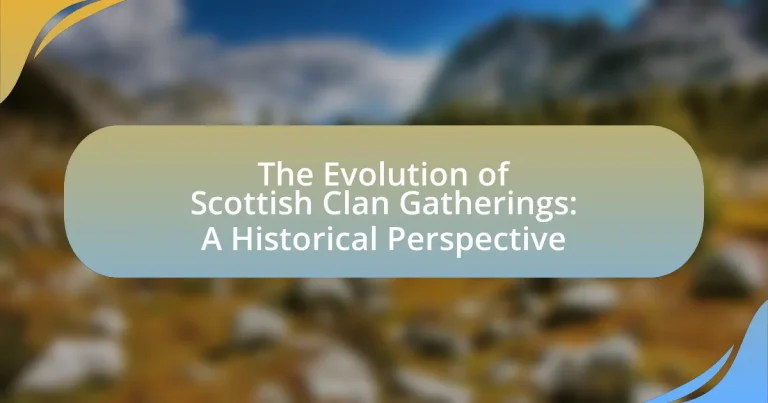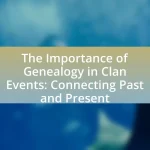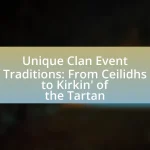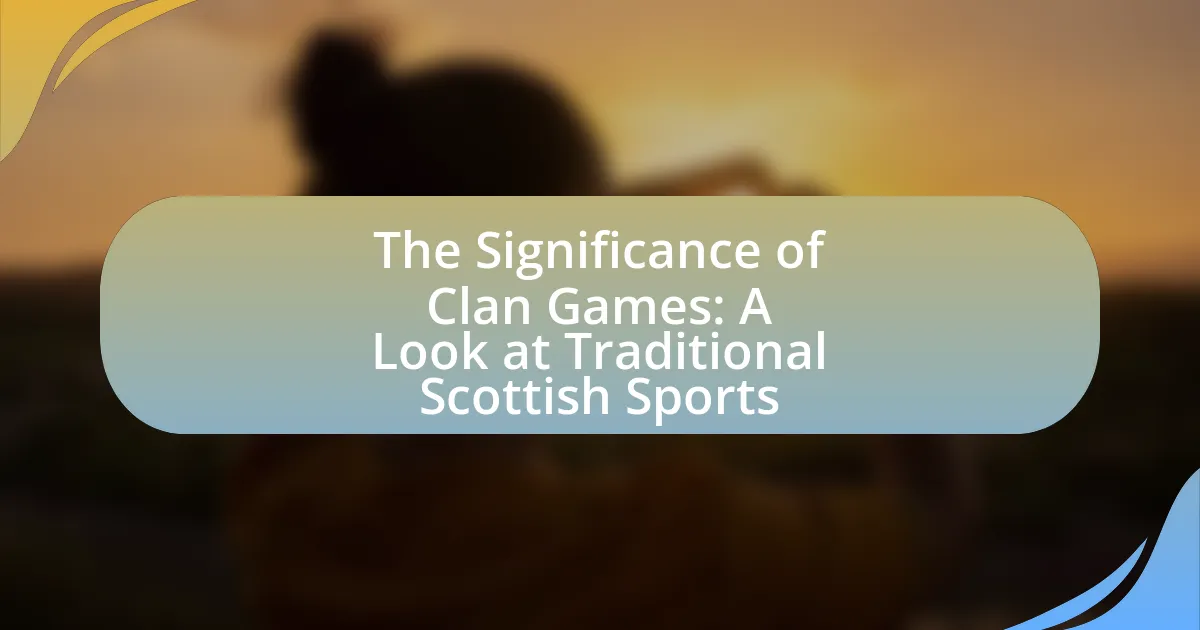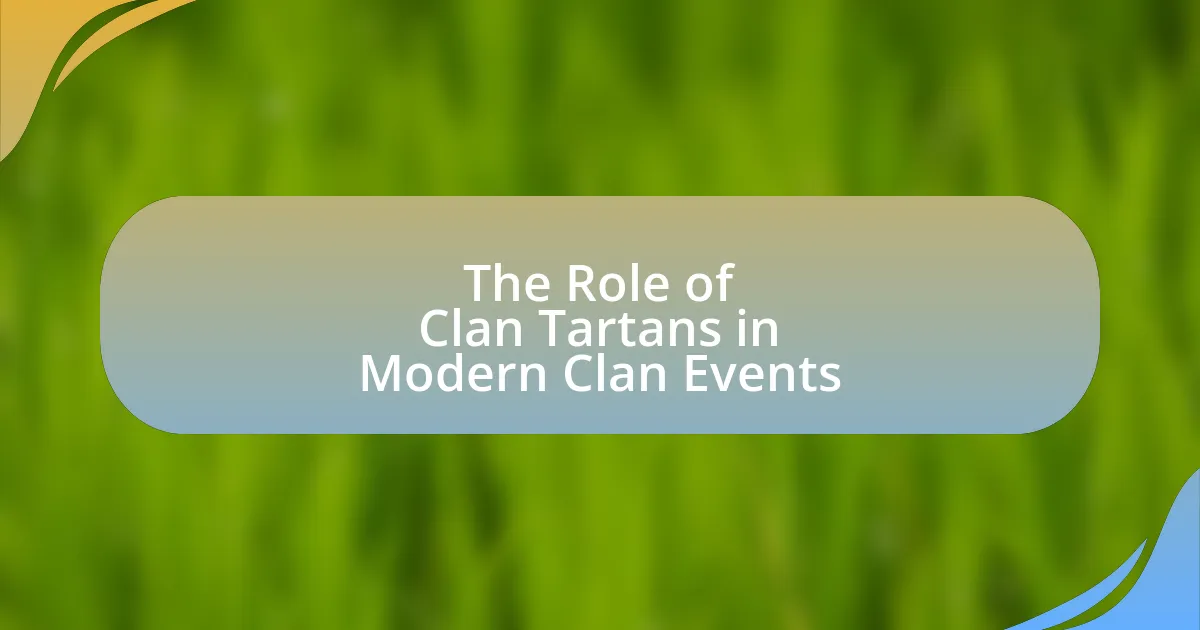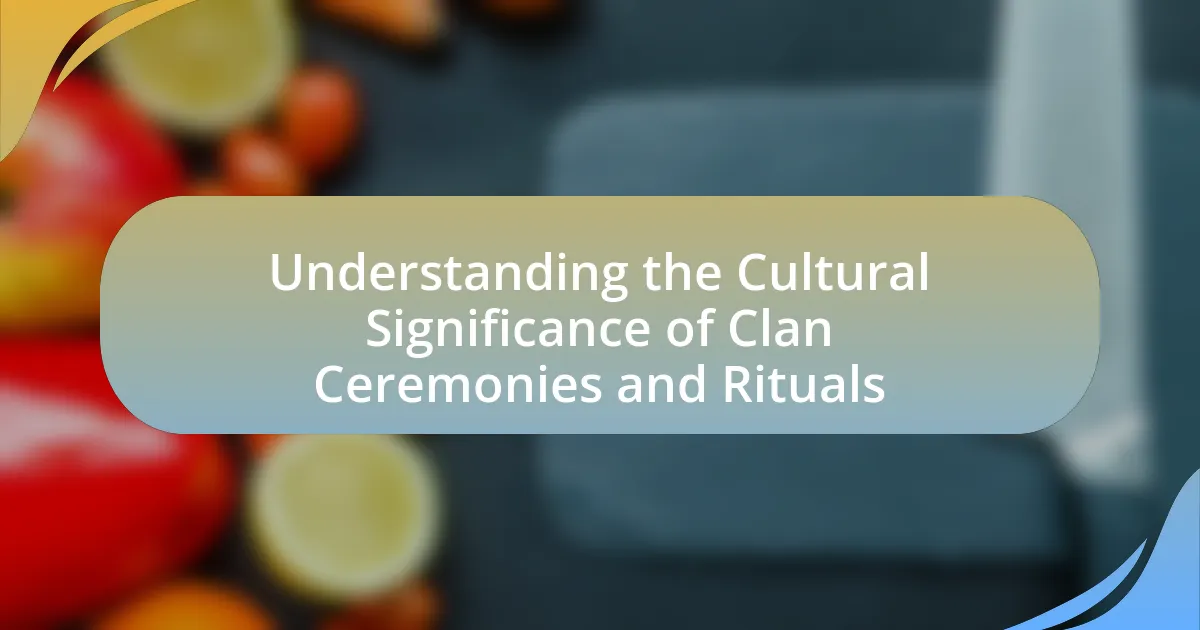Scottish Clan Gatherings are significant cultural events that bring together members of specific clans to celebrate their heritage and identity. Historically, these gatherings have evolved from military assemblies in the feudal period to modern cultural festivals, reflecting changes in social and political dynamics in Scotland. The article explores the origins, historical significance, and evolution of clan gatherings, detailing their role in fostering community, preserving traditions, and adapting to contemporary challenges. Key activities associated with these gatherings, such as athletic competitions and cultural performances, are highlighted, along with the impact of globalization and technology on participation and organization. The discussion also addresses the challenges faced by modern clan gatherings and strategies for enhancing engagement among younger generations.
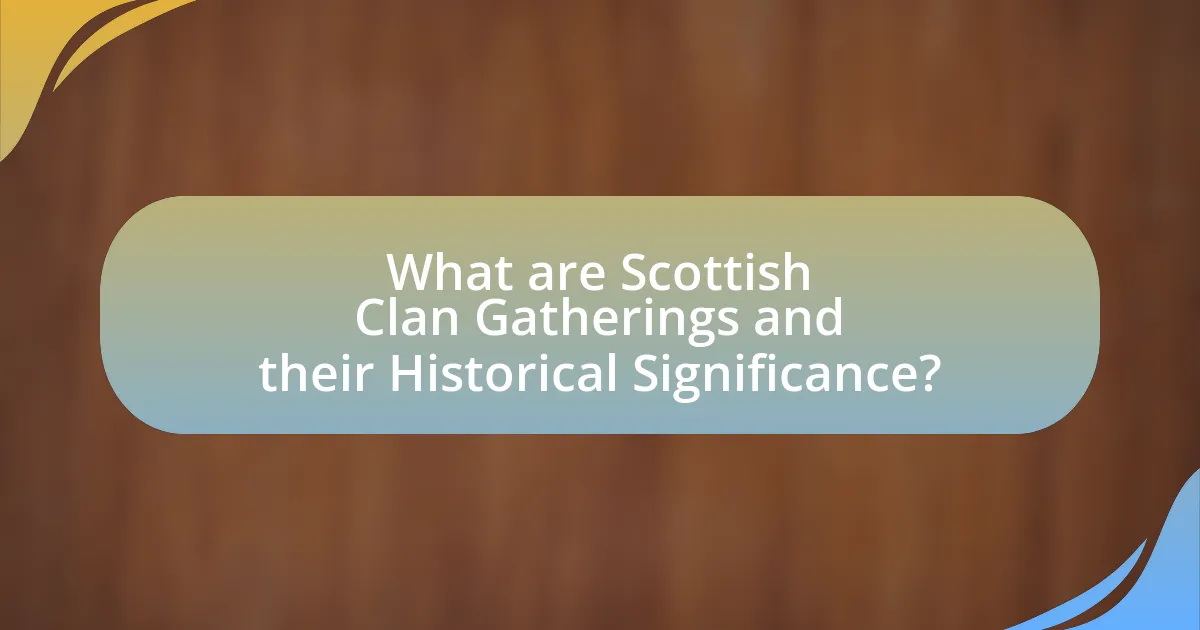
What are Scottish Clan Gatherings and their Historical Significance?
Scottish Clan Gatherings are events where members of a specific clan come together to celebrate their heritage, culture, and identity. Historically, these gatherings have served as important social and political functions, reinforcing clan loyalty and unity, particularly during times of conflict or change in Scotland. For example, the first recorded clan gathering took place in 1314 at the Battle of Bannockburn, where clans united against English rule, showcasing their collective strength. These events have evolved over time, transitioning from military assemblies to cultural festivals, thereby preserving Scottish traditions and fostering community among descendants.
How did Scottish Clan Gatherings originate?
Scottish Clan Gatherings originated as a means for clans to unite for social, political, and military purposes. Historically, these gatherings were crucial for maintaining clan identity and solidarity, especially during the feudal period when clans were often involved in conflicts and alliances. Evidence from historical records indicates that such gatherings, known as “clan feuds” or “clan meetings,” were organized to discuss matters of governance, resolve disputes, and celebrate cultural traditions, particularly during the 15th and 16th centuries. The significance of these gatherings is further supported by the establishment of formal clan structures and the role of clan chiefs in leading these events, which solidified their importance in Scottish society.
What were the early forms of clan gatherings in Scotland?
Early forms of clan gatherings in Scotland included communal assemblies known as “clan moots” or “clan meetings,” where members would convene to discuss matters of importance, resolve disputes, and make collective decisions. These gatherings often took place in open spaces or designated areas within the clan’s territory, emphasizing the importance of kinship and unity among clan members. Historical records indicate that such meetings were crucial for maintaining social order and reinforcing loyalty within the clan structure, particularly during the medieval period when clans were integral to Scottish society.
How did social and political factors influence the formation of these gatherings?
Social and political factors significantly influenced the formation of Scottish clan gatherings by fostering a sense of identity and unity among clan members. The rise of clan loyalty during the feudal system, where clans served as both social and military units, necessitated gatherings for strategic alliances and communal decision-making. Historical events, such as the Jacobite uprisings, further galvanized clan solidarity, prompting large-scale gatherings to demonstrate strength and support for political causes. Additionally, the enactment of laws, such as the Disarming Act of 1746, which sought to suppress clan power, ironically led to increased gatherings as clans sought to preserve their heritage and resist external control. These gatherings became crucial for maintaining cultural traditions and reinforcing social bonds within the clan structure.
What role did clan gatherings play in Scottish society?
Clan gatherings played a crucial role in Scottish society by serving as a means of social cohesion and political organization among clans. These gatherings facilitated the reinforcement of clan identity, allowed for the discussion of communal issues, and provided a platform for the display of loyalty to clan leaders. Historically, events such as the Clan MacGregor’s gathering in 1644 exemplified how these meetings were pivotal for rallying support during conflicts, thereby influencing the political landscape of Scotland. Additionally, clan gatherings often included rituals, feasting, and competitions, which helped to strengthen bonds among members and maintain cultural traditions.
How did clan gatherings foster community and identity among Scots?
Clan gatherings fostered community and identity among Scots by serving as vital social events that reinforced kinship ties and cultural heritage. These gatherings provided a platform for clans to unite, celebrate shared traditions, and strengthen relationships among members, thereby enhancing a sense of belonging. Historical records indicate that events like the Highland Games and clan feasts were not only occasions for competition and entertainment but also opportunities for clans to assert their identity and solidarity, particularly during times of political strife. The participation of clan leaders and the display of clan symbols, such as tartans and crests, further solidified this communal identity, making clan gatherings essential for maintaining the social fabric of Scottish society.
What were the key activities and traditions associated with these gatherings?
Key activities and traditions associated with Scottish clan gatherings included ceremonial events, athletic competitions, and social festivities. Ceremonial events often featured the display of clan banners, traditional music, and dance, which fostered a sense of identity and unity among clan members. Athletic competitions, such as caber tossing and tug-of-war, showcased physical strength and skill, reflecting the clan’s values and heritage. Social festivities included feasting and storytelling, which reinforced clan bonds and preserved oral histories. These activities were integral to maintaining clan culture and solidarity throughout history.
How have Scottish Clan Gatherings evolved over time?
Scottish Clan Gatherings have evolved from localized, clan-specific events focused on kinship and military alliances to large-scale, public celebrations that emphasize cultural heritage and community. Historically, these gatherings served as opportunities for clans to unite for defense and political purposes, particularly during the feudal period in Scotland. Over time, especially from the 19th century onwards, the gatherings transformed into festivals that celebrate Scottish culture, featuring music, dance, and traditional games, reflecting a broader interest in national identity and heritage. The establishment of events like the Highland Games and the proliferation of clan societies have further contributed to this evolution, making clan gatherings accessible to a wider audience and promoting a sense of belonging among Scots worldwide.
What major historical events impacted the evolution of clan gatherings?
Major historical events that impacted the evolution of clan gatherings include the Jacobite uprisings, the Act of Union in 1707, and the Highland Clearances. The Jacobite uprisings, particularly those in 1715 and 1745, galvanized clan loyalty and unity, leading to large gatherings for support and recruitment. The Act of Union, which merged the Scottish and English parliaments, diminished the political power of clans, causing gatherings to shift from political to social and cultural celebrations. The Highland Clearances in the 18th and 19th centuries forced many clans to disperse, leading to a decline in traditional gatherings but also inspiring a revival of interest in clan heritage and identity in later years.
How did the Jacobite uprisings affect clan gatherings and their significance?
The Jacobite uprisings significantly altered clan gatherings by transforming them from social and cultural events into politically charged assemblies. Following the uprisings, particularly after the defeat at Culloden in 1746, clan gatherings became less frequent due to increased government scrutiny and repression of Highland culture. The British government sought to dismantle the clan system, leading to a decline in the traditional gatherings that had previously reinforced clan identity and solidarity. This shift is evidenced by the 1746 Dress Act, which prohibited the wearing of tartan and other Highland dress, further diminishing the significance of these gatherings as expressions of clan loyalty and heritage.
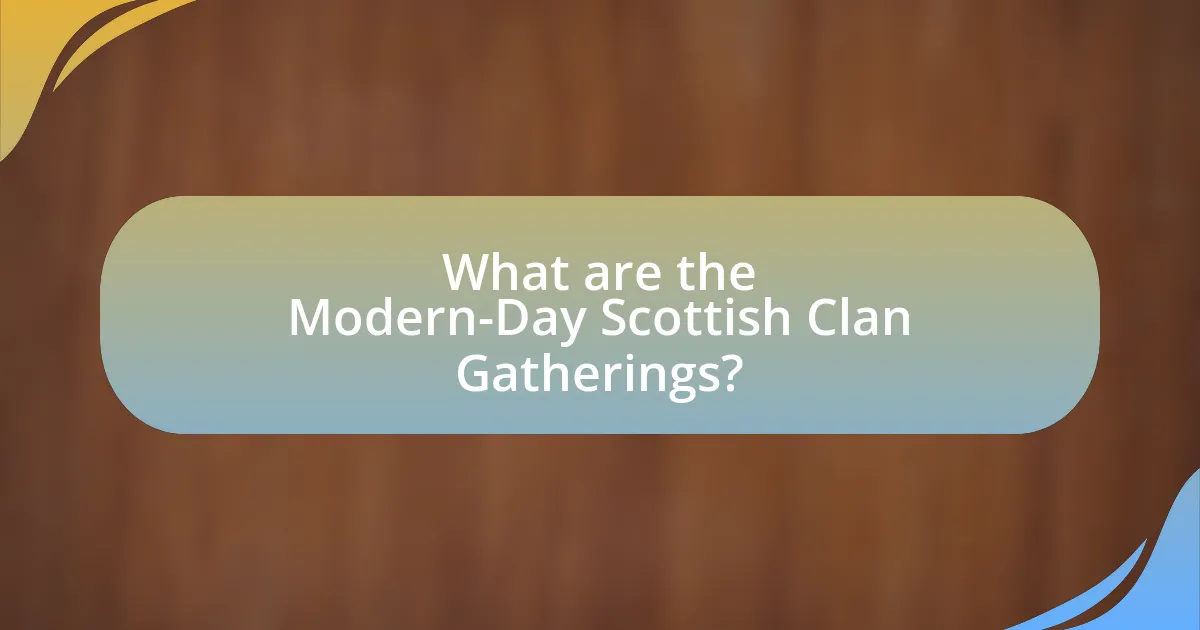
What are the Modern-Day Scottish Clan Gatherings?
Modern-day Scottish clan gatherings are events where members of specific clans come together to celebrate their heritage, culture, and community. These gatherings often include traditional music, dancing, games, and competitions, such as tug-of-war and caber tossing, reflecting the historical practices of Scottish clans. Notably, the largest gathering occurs at the Royal Edinburgh Military Tattoo and the Gathering at Edinburgh, which attracts thousands of participants and spectators, showcasing clan pride and unity. These events serve as a means to strengthen familial ties and preserve Scottish traditions, with many clans also engaging in charitable activities during these gatherings.
How do contemporary clan gatherings differ from historical ones?
Contemporary clan gatherings differ from historical ones primarily in their focus on cultural celebration rather than military or political alliances. Historically, clan gatherings served as crucial events for consolidating power, resolving disputes, and planning military actions, often reflecting the feudal system’s hierarchical nature. In contrast, modern gatherings emphasize heritage, community bonding, and cultural activities, such as music, dance, and storytelling, reflecting a shift towards inclusivity and celebration of identity rather than conflict. This evolution is evidenced by the rise of events like the Scottish Highland Games, which prioritize cultural expression over historical feuds, showcasing a transformation in the purpose and atmosphere of clan gatherings.
What are the main features of modern clan gatherings?
Modern clan gatherings primarily feature cultural celebrations, community bonding, and heritage preservation. These events often include traditional music and dance performances, showcasing the clan’s unique cultural identity. Additionally, modern gatherings frequently incorporate educational workshops and discussions about clan history, genealogy, and Scottish traditions, fostering a sense of belonging among members. Many gatherings also emphasize outdoor activities, such as sports and games, which promote camaraderie and physical engagement. The presence of food and drink, particularly traditional Scottish cuisine, further enhances the communal atmosphere, allowing participants to share in their heritage.
How do modern gatherings reflect the heritage and traditions of Scottish clans?
Modern gatherings reflect the heritage and traditions of Scottish clans through the celebration of cultural practices, traditional attire, and clan-specific rituals. These events often feature Highland games, which showcase athletic competitions rooted in historical clan rivalries, and provide a platform for clans to display their unique tartans and crests, reinforcing clan identity. Additionally, gatherings include storytelling, music, and dance that preserve and promote the oral traditions and folklore of Scottish clans, ensuring that their history and values are passed down through generations. Such events serve as a living testament to the enduring legacy of Scottish clans, fostering community and connection among members while honoring their ancestral roots.
What is the significance of clan gatherings in today’s Scotland?
Clan gatherings in today’s Scotland serve as vital cultural events that reinforce identity, heritage, and community among Scots and their descendants. These gatherings provide a platform for individuals to connect with their clan’s history, fostering a sense of belonging and continuity. Historically, clan gatherings date back to the 12th century, where they were crucial for social, political, and military alliances. In contemporary times, events such as the Clan Gathering at the Scottish Parliament and the International Clan Gathering in Edinburgh attract thousands, highlighting the enduring significance of clan identity in modern Scottish society. These events not only celebrate Scottish culture but also promote tourism and economic activity, demonstrating their relevance in today’s socio-economic landscape.
How do clan gatherings contribute to cultural preservation in Scotland?
Clan gatherings contribute to cultural preservation in Scotland by serving as a platform for the transmission of traditions, language, and heritage among clan members. These events facilitate the sharing of historical narratives, music, and dance, which are integral to Scottish identity. For instance, the annual Clan Gathering at the Clan Macpherson Museum showcases traditional Scottish games, storytelling, and Gaelic language workshops, reinforcing cultural ties and fostering a sense of belonging. Additionally, such gatherings often include ceremonies that honor ancestral lineage, thereby maintaining the historical significance of clans in Scottish society.
What role do clan gatherings play in fostering connections among Scots worldwide?
Clan gatherings play a crucial role in fostering connections among Scots worldwide by providing a platform for cultural exchange and community building. These events allow individuals of Scottish descent to reconnect with their heritage, share traditions, and strengthen familial ties. Historically, clan gatherings have served as a means to celebrate shared ancestry, with events such as the Clan Gathering at the Edinburgh Tattoo attracting thousands of participants from various countries, reinforcing a sense of belonging and identity among Scots globally.
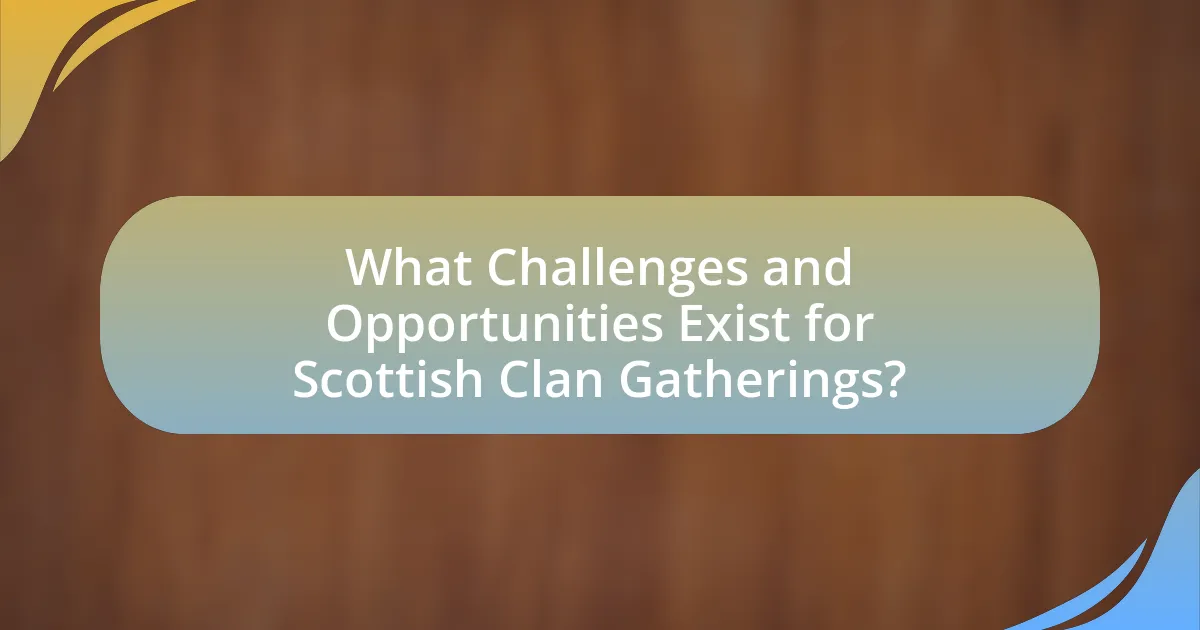
What Challenges and Opportunities Exist for Scottish Clan Gatherings?
Scottish clan gatherings face challenges such as declining participation and logistical issues, while also presenting opportunities for cultural revitalization and community engagement. Declining participation is evidenced by a reduction in attendance at traditional events, which can be attributed to modern lifestyle changes and the dispersal of clan members globally. Logistical issues include organizing events that cater to diverse interests and ensuring accessibility for all attendees. Conversely, opportunities arise from the growing interest in heritage tourism, which can attract visitors and foster a sense of belonging among clan members. Additionally, the rise of social media facilitates connections among dispersed clans, enabling them to organize and promote gatherings more effectively.
What challenges do modern clan gatherings face?
Modern clan gatherings face challenges such as declining participation, cultural dilution, and logistical issues. Declining participation is evident as younger generations show less interest in traditional clan activities, leading to reduced attendance at events. Cultural dilution occurs when the original customs and practices of clans are overshadowed by contemporary influences, resulting in a loss of authenticity. Logistical issues include the difficulties in organizing events that accommodate diverse members spread across different regions, which complicates planning and execution. These challenges threaten the sustainability and relevance of clan gatherings in today’s society.
How has globalization affected the participation in clan gatherings?
Globalization has increased participation in clan gatherings by facilitating communication and travel among dispersed clan members. As clans have members living worldwide, advancements in technology and transportation have made it easier for individuals to connect and attend gatherings, regardless of their geographical location. For instance, the rise of social media platforms allows clans to organize events and share information rapidly, leading to higher attendance rates. Additionally, the global interest in heritage and cultural identity has prompted many individuals to seek out their clan roots, further boosting participation in these gatherings.
What are the financial and organizational challenges of hosting these events?
Hosting Scottish clan gatherings presents significant financial and organizational challenges. Financially, event organizers must secure funding for venue rentals, permits, catering, and promotional materials, which can be substantial given the scale of these gatherings. For instance, a large clan gathering can cost upwards of tens of thousands of dollars, necessitating sponsorships or ticket sales to cover expenses.
Organizationally, coordinating logistics such as scheduling, transportation, and accommodation for attendees poses a complex challenge. Effective communication among clan members and stakeholders is crucial, as mismanagement can lead to low attendance or logistical failures. Historical data indicates that poorly organized events often result in financial losses and diminished clan cohesion, underscoring the importance of meticulous planning and execution.
What opportunities can enhance the future of Scottish Clan Gatherings?
To enhance the future of Scottish Clan Gatherings, integrating digital technology and virtual participation is essential. This approach allows clans to connect globally, expanding attendance beyond geographical limitations. For instance, the use of live streaming and social media platforms can facilitate real-time engagement, enabling members from various locations to participate in events and discussions. Additionally, incorporating educational workshops and cultural exchanges can enrich the experience, fostering a deeper understanding of clan heritage and traditions. Historical data shows that events with interactive elements attract higher participation rates, indicating that modernizing the format can significantly boost interest and involvement in clan gatherings.
How can technology be leveraged to promote clan gatherings?
Technology can be leveraged to promote clan gatherings by utilizing social media platforms, event management apps, and virtual meeting tools. Social media platforms like Facebook and Instagram allow clans to create dedicated pages or groups, facilitating communication and engagement among members. Event management apps, such as Eventbrite, enable clans to organize and promote gatherings efficiently, providing features for ticketing, RSVPs, and reminders. Virtual meeting tools like Zoom or Microsoft Teams can connect clan members who are geographically dispersed, allowing for online gatherings and discussions. These technologies enhance outreach and participation, as evidenced by a 2021 study from the Pew Research Center, which found that 72% of adults use social media to connect with family and friends, indicating a strong potential for clan engagement through these platforms.
What strategies can clans adopt to engage younger generations in gatherings?
Clans can engage younger generations in gatherings by incorporating modern technology and interactive activities. Utilizing social media platforms to promote events and share experiences can attract younger members, as studies show that 90% of millennials use social media regularly. Additionally, integrating activities such as workshops, games, and cultural performances that resonate with younger interests can enhance participation. For instance, offering hands-on experiences related to traditional crafts or music can create a more engaging atmosphere. These strategies not only foster a sense of belonging but also ensure that the cultural heritage is passed down in a way that is relevant to younger audiences.
What are some best practices for organizing a successful clan gathering?
To organize a successful clan gathering, it is essential to establish a clear purpose and plan logistics meticulously. Defining the gathering’s objectives, such as celebrating heritage or fostering community, guides the planning process. Logistics should include selecting an accessible venue, scheduling activities that cater to all ages, and ensuring adequate accommodations for attendees.
Additionally, effective communication is crucial; utilizing social media and clan newsletters can enhance outreach and engagement. Historical evidence shows that well-organized gatherings, such as the Clan Campbell Gathering in 2019, attracted over 1,000 participants, demonstrating the importance of thorough planning and community involvement.
What key elements should be considered when planning a clan gathering?
Key elements to consider when planning a clan gathering include location, timing, activities, and communication. The location should be accessible and meaningful to clan members, often tied to historical significance or natural beauty. Timing is crucial; selecting a date that accommodates the majority of members ensures higher attendance. Activities should reflect clan traditions and interests, such as games, storytelling, or cultural performances, fostering a sense of community. Effective communication is essential for organizing the event, including clear invitations and updates to keep members informed. These elements are supported by historical practices of clan gatherings, which emphasized community, heritage, and shared experiences.
How can clans effectively promote their gatherings to increase participation?
Clans can effectively promote their gatherings to increase participation by utilizing social media platforms, local community outreach, and engaging storytelling. Social media allows clans to reach a wider audience, as platforms like Facebook and Instagram can be used to share event details, photos from past gatherings, and testimonials from participants, which can enhance interest and engagement. Local community outreach, such as collaborating with local businesses or organizations, can help to spread the word and attract attendees who may not be directly connected to the clan. Engaging storytelling about the clan’s history and significance can create a sense of belonging and encourage participation, as individuals are often drawn to narratives that resonate with their identity. These methods have been shown to increase attendance at events, as evidenced by various clan gatherings that report higher participation rates when actively promoted through these channels.
